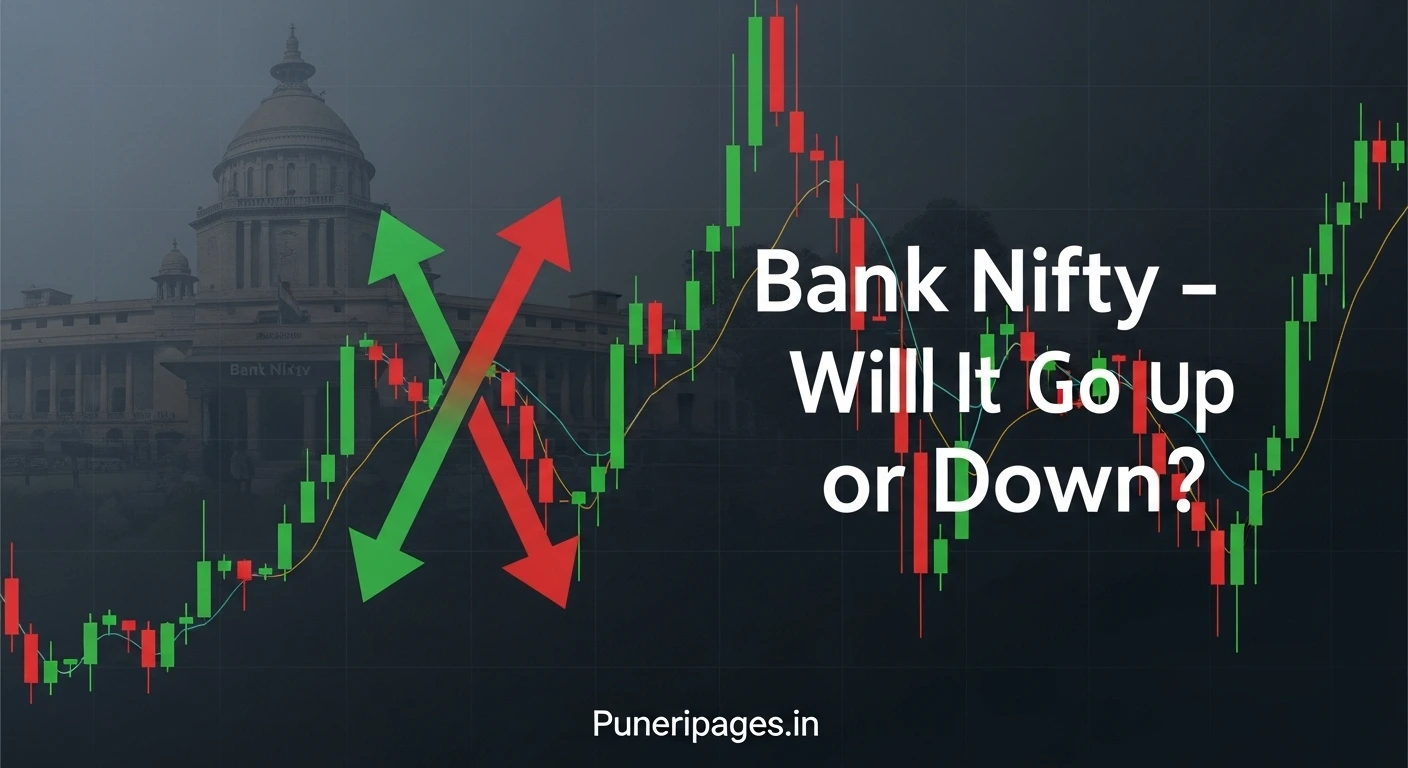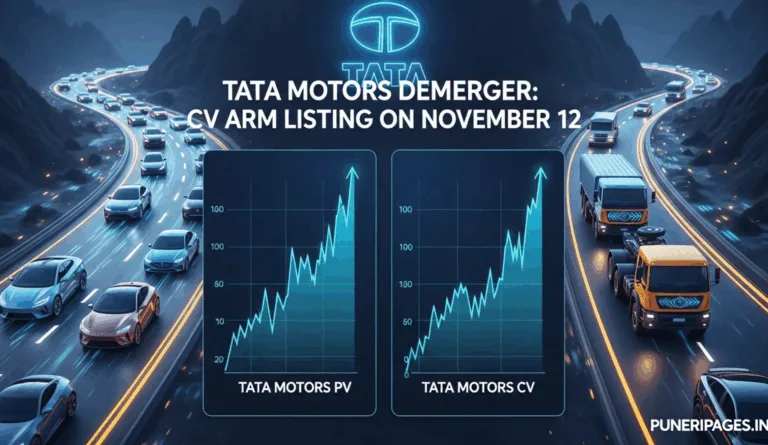
Bank Nifty can turn bullish or bearish in minutes. Learn the simple framework traders use to know if Bank Nifty will go up or down — with charts, fundamentals, and RBI cues. By Puneripages.in
By Shreyal for PuneriPages.in
If you’ve ever searched “How to know if Bank Nifty will go up or down”, I get it — it’s the question that every trader and investor keeps asking almost daily. Having traded Bank Nifty options myself, I’ve seen how one RBI announcement, one inflation print, or even one FII outflow can flip the market from bullish to bearish in hours.
The honest truth? Nobody — not even the smartest analyst on Dalal Street — can guarantee the exact next move of Bank Nifty. But here’s the good news: there are frameworks, tools, and indicators that can give us probabilities. And in trading, probabilities matter more than certainties.
In this article, I’ll break down the main things I personally watch when trying to figure out if Bank Nifty will climb higher or face a correction. We’ll look at technical charts, fundamentals of banks, RBI policy, and macroeconomic cues. And most importantly, I’ll keep it simple, human, and practical.
Table of Contents
Understanding Bank Nifty: What Drives the Index?
Before we jump into “signals,” let’s quickly remember what Bank Nifty is:
- Bank Nifty (Nifty Bank) represents the performance of the top banking stocks listed on NSE.
- It’s a sectoral index, so its movement is tied directly to the health of banks and indirectly to the broader economy.
- Major weightage: HDFC Bank, ICICI Bank, SBI, Kotak Mahindra Bank, Axis Bank, IndusInd Bank.
So, if these giants show strong earnings, stable NPAs, and good credit growth, Bank Nifty usually trends higher. On the other hand, rising NPAs, poor earnings, or RBI tightening liquidity usually put pressure on the index.
Technical Analysis: Charting the Course
From my experience, most short-term traders rely on technical indicators. Here’s how I use them to gauge if Bank Nifty will go up or down.
1. Support & Resistance Levels
- Support = levels where buying usually comes in (floor).
- Resistance = levels where selling usually appears (ceiling).
- Example: If Bank Nifty has bounced multiple times near 45,000, that’s a support. If it struggles near 47,500, that’s resistance.
- A breakout above resistance often signals upside momentum; a breakdown below support signals weakness.
2. Moving Averages (EMA, SMA)
- The 200-day EMA is like a market mood indicator.
- If Bank Nifty trades above it, trend is considered bullish; below it, bearish.
- I often combine the 20-day EMA and 50-day EMA to catch shorter-term trends. A “golden cross” (20 EMA crossing above 50 EMA) usually hints at strength.
3. Momentum Indicators (RSI, MACD)
- RSI (Relative Strength Index): Above 70 = overbought, Below 30 = oversold.
- MACD (Moving Average Convergence Divergence): If MACD line crosses above signal line, that’s bullish momentum.
4. Volatility Indicators (India VIX, Bollinger Bands)
- High India VIX = higher volatility, often meaning sharp swings in Bank Nifty.
- Bollinger Bands help me see when the index is stretched too far in one direction — a squeeze often predicts a breakout.
5. Chart Patterns (Candlestick, Reversal Patterns)
- Double tops, head-and-shoulders, or bullish engulfing candles often give strong directional hints.
- For example, a hammer candle near support often signals reversal upwards.
👉 Practical takeaway: No single indicator is gospel. I look for confluence — if RSI is oversold, price is near strong support, and MACD is turning bullish, odds of an upward move are better.
Fundamental Analysis: The Health of Banks
Technical charts are great for timing entries and exits, but fundamentals tell you the bigger picture. Bank Nifty’s direction depends on how strong the banking sector is fundamentally.
1. NPA (Non-Performing Assets) Trends
- If major banks report declining NPAs, it shows better asset quality = bullish signal.
- Rising NPAs = stress in lending books = bearish signal.
2. NIM (Net Interest Margin) & Credit Growth
- Higher NIMs mean banks are earning more on loans relative to what they pay on deposits.
- Robust credit growth (more loans being disbursed) signals strong demand and boosts profitability.
3. CASA Ratio & Deposits
- CASA = Current Account Savings Account.
- Higher CASA means banks have cheaper deposits, improving margins.
4. Quarterly Results & Earnings Forecasts
- I always track Q results of HDFC, ICICI, and SBI. If these three show strong earnings, Bank Nifty usually rallies.
👉 Practical takeaway: Strong fundamentals don’t guarantee short-term rallies, but they give you confidence in the medium-term trend.
Macroeconomic Factors: The Big Picture
Even if technicals and fundamentals look good, macro factors can spoil the party.
RBI Monetary Policy
- Repo Rate changes directly affect bank lending and borrowing.
- A repo rate cut usually supports Bank Nifty (cheaper loans, better margins).
- A hike may pressure it.
Inflation & GDP Growth
- Low inflation = scope for RBI to ease.
- Strong GDP = more demand for loans.
Global Market Cues & FII/DII Flows
- Bank Nifty is heavily influenced by FII (foreign institutional investors).
- If FIIs are selling Indian equities due to global cues, Bank Nifty often weakens regardless of domestic fundamentals.
Risk Management & Disclaimer
Now, let me be very clear: there is no formula to 100% predict Bank Nifty’s next move.
Markets can and will surprise you. That’s why risk management is non-negotiable.
- Always use stop-losses.
- Never risk more than 1–2% of your capital on a single trade.
- Avoid chasing moves based on “tips.”
- Combine indicators and look for confluence instead of depending on one signal.
👉 Remember: These tools provide probabilities, not guarantees.
Putting It All Together: A Practical Framework
Here’s how I personally approach the question:
- Start with the bigger picture (RBI policy, global cues, inflation).
- Check fundamentals of the top banks (NPAs, NIMs, credit growth).
- Mark key technical levels (support, resistance, moving averages).
- Look for confirmation from momentum indicators (RSI, MACD).
- Decide the bias (bullish, bearish, neutral) for the next few sessions.
- Enter with a stop-loss and clear risk-reward.
When these align, I take trades with confidence. When they don’t, I prefer to stay out — because sometimes the best trade is no trade.
Final Word: So, How to Know if Bank Nifty Will Go Up or Down?
If you came here searching “How to know if Bank Nifty will go up or down”, here’s the bottom line:
- You can’t predict with certainty.
- But you can prepare with probability using technicals, fundamentals, and macro cues.
- Experienced traders focus on discipline, confluence of signals, and strict risk management — not just predictions.
So next time you look at Bank Nifty, don’t ask “Will it go up or down?” Instead, ask:
👉 “What do the indicators, fundamentals, and macros suggest — and how can I manage my risk around it?”
That’s how you trade smart.






